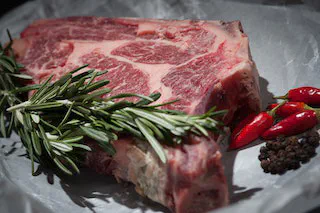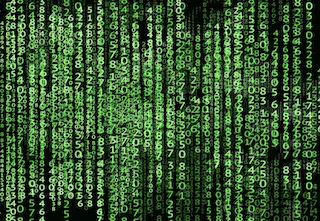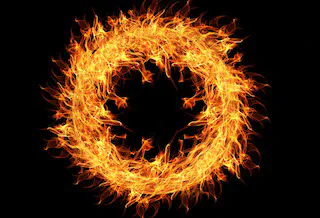
Could meat be the healthiest choice if your blood type is O?
- Matthieu P.J.
- Wellbeing
- August 17, 2023
The human body and its digestive system have evolved to function on a variety of diets. Yet, there is one diet that is most appropriate for you. But will you ever find out what it is? Will you authorise yourself to experiment and go beyond the status quo and conventional—yet sometimes untrue—wisdom?
I found nutrition to be one of the areas the most difficult to navigate. Everyone has gone their own opinion about it, yet there’s only one proof in the pudding: your body response. It is so obvious and so simple, and yet we often resist it and try to make an intellectual understanding out of it. Wrong direction! There’s only one judge: your body. And you must listen.
There are clues left to yourself. The blood type is one. People who have an O blood type are similar to the first human that were around. And that was before agriculture. That was the so-called hunter-gatherers. First clue.
Second clue you should pick up on: in the Western world, the proportion of cancer and diseases in general is just staggering. It will dawn on you that there must be something fundamental we are getting wrong, collectively. Just because we live in a world where we normalise ‘dis-ease’ does not mean it has to be that way. Far from it! So what is it we’re not getting right? I talked about that in The tragedy of grains . The tragedy is that in order to develop humanity and feed people en masse, we came up with an answer: agriculture. Grains with their carbohydrates are a source of calories that can be stored and used with convenience. Granted, it has allowed a massive development of humanity. But people were living lives short enough that the real problem of that diet would not really hit the surface.
Third clue: the domestication of sugar and its mass production since the 19th century. Once a rarity, sugar has become a staple food on the tables throughout the world. Our ancestors only had the sweet taste in limited food choice: fruits and honey for example. Today, sugar is added to all sorts of food. And that is not a minor thing. Sugar is plain toxic for our body, is the real source of many diseases and is so addictive (more than other so-called hard drugs) that in fact we’ve created a civilisation that runs on sugar—among other debatable things e.g.: nicotine, alcohol, chocolate, coffee and tea…
Here’s a key fact to understand. Your body can run on 2 sources of fuel: carbs or fat. Carbs turn into sugar in your body. Granted, glucose is the fuel for your body at the cellular level, especially the brain that uses most of it. When you eat carbs, the pathway to glucose is quick. It even gives you a high when you eat carbs (e.g. rice, pasta, bread etc.) ! But you can only notice it once you’re off sugar. So carbs is the easy and seducing route. But it’s not the only one…
The path of fat—healthy fat, we mean—is different. Fat ingested without carbs are not the problem, in fact olive oil for example is very nutritious and brings in calories. Omega 3 are anti-inflammatory and certainly fat got a bad press over the years, to be often replaced by… more sugar. When you eat high amount of fat, your body is satisfied and does not crave more of it, because it’s digested slowly and it does not mess up with you blood sugar levels. And that’s where the Keto and Paleo diets come in.
- Keto diet says that 70% of what you eat should be fat, 20% protein and the remainder 10% carbs. It means that fats are where you primary calorie intake is. Quite a radical difference compared to the western diet where carbs are dominant. Not only that, their source is concentrated in only a few grains on top of which wheat.
- Paleo diet argues that we should return to what the cavemen were eating before the introduction of agriculture, that means: meat, fish, eggs, healthy fat, nuts and seeds and non-starchy vegetables. Basically: forget the grains, legumes, sugar and processed food.
- Keto shares a large common denominator with Paleo, except those differences. Keto says dairy is OK but no fruits or starchy vegetables. Paleo says dairy are not OK, but fruits and starchy vegetables are.
And the interesting thing is that people can thrive on either diet. Actually, some people can even thrive on a carnivorous diet. And I am not advocating that to everyone, I am just saying: if your blood type is O, there’s something to explore here.
There’s been a lot of conditioning in our modern societies about what we’re supposed to eat or not. We’ve heard all sorts of things, some being only used as an outlet for selling some goods. Notably the dairy industry recommended to have your milk for calcium and strong bones—we know today it’s not true. In France, until rather recently, they said drinking wine was good for health—when you know the first drop of alcohol is plain toxic for your body, that makes you smile. And another one, that we need to eat lots of vegetables to get our fiber.
That’s when came across the myth of fiber… Fiber are the part of food you don’t digest and that gets out with your stool. We’re told that ingesting those food that we know have no use for us is actually good for us. Except that some specialists strongly disagree. What if the fiber was actually damaging your digestive system because of the extra burden it puts on them?
Eating has become a social activity. Cuisine and the art of preparing tasty and appealing meals is well rooted in human cultures. But consider the requirements of your body too: simple, high nutrient, easily digestible food are best.
I doubt we were supposed to have so much variety in our food. Such variety confuses the body and the digestive system that needs to release certain enzymes and acid to process and digest the food. Have you ever hear “don’t mix carbs and fat”? Well, that’s a well-known fact that eaten together they are wreaking havoc on your body. A hamburger fries with the carbs of the fries and bun, the fat of the cooking oil for fries and from the beef, and the sweet ketchup and other sauces on top is a toxic cocktail for your body. It doesn’t mean you can’t have it once in a while, but it means that making it a regular food is madness.
Contrary to the epicurean vision of fine dining, there’s also a utilitarian way of eating: trying to minimise the stress on your digestive system, and promote wellbeing. The gut has got neurons in it, lots actually. It’s sometimes called the second brain. The feeling that flushes through your body after a meal influences your mood and mental health. But has someone ever told you that? Has someone ever told you that for feeling good in your life, including with less anxiety and a good mood, you should also closely watch what you eat? Probably not. It’s well-known that for GPs, the nutrition teaching is about a few days among years of medical study. We’re not looking at the right things here. Someone smart said a long time ago: “Let the food be thy medicine.” Why have so many people decided not to listen?
The case of meat now. OK, killing animals may be against your beliefs, you may be vegetarian or vegan by conviction and that’s your mind speaking—but not your body. Some people’s body will thrive on a meat-based diet, regardless of their spiritual views. And there’s something you rarely hear about meat (or fish): the flesh of animals is not toxic to you. There’s no natural protection an animal takes not to be eaten. But in the vegetal kingdom, that is the norm! Did someone ever tell you about anti-nutrients and all the natural protection the plants take so that they are not digested by animals. Seeds and vegetables of all sorts have them. For example, the nightshades family whose tomato is a member is notorious for making people have a difficult digestion.
I know the vegans out there won’t agree. Killing animals here, ‘stealing’ their eggs there, they find it immoral and I respect their position. But here’s mine: the human body is part of the animal kingdom, and trying to convince yourself otherwise is just fooling with nature. Our body has got needs: eat, drink, sleep, have sex. We should not feel ashamed of meeting our needs.
There’s also what I call eating freedom. You can either eat low calories density food : eat the seeds, the vegetables and fruits. Or you can eat the high calories density food: protein and fat. The amount of time you need eating throughout the day is greatly reduced when you go with the latter. Because it gives you sustenance. Just look at nature: herbivorous animals graze eat for hours on during the day, whereas a carnivorous animal will kill a prey and get on with it sometimes for days.
High calories density food also gives a break to your digestive system between meals. Snacking is when you’re not properly fed. You always feel hungry. After having the modern bread with all its white starch that turns into sugar, you get a spike of sugar in your blood and inevitably you’ll crash within 2 hours of it. And feel like eating again. A vicious circle… until you finally understand what’s going on.
When you’re eating some real nutritious food, you’re not hungry. And your day is not planned around your meals—something I abhor. Instead, your day is planned around your life and every now and then you remember about eating because your body healthily asks for it. It’s not a sugar craving, it’s just food craving, a “please feed me” signal sent to the brain. The kind of message most people are not even perceiving anymore because they forgot what it is to feel hungry. They’re constantly in a sugar fog.
People have been so conditioned from childhood about eating habits that they become unable to think objectively about what proper nutrition is. If there’s anything you need to take way from this article: consider the—high—possibility that your current diet may be largely sub-optimal for your body. I’m here to say that you could well be thriving on a diet inspired by the Keto and Paleo guidelines if your blood type is O.
Go beyond what you feel is OK or not OK. Allow yourself to experiment. Help your body reclaim the health it deserves. Try to reduce the variety of food in your meals. See what happens. Start with the three big groups: carbs, fat and protein. Cut off carbs, go past the withdrawal symptoms (because you’re likely addicted to sugar like millions of other people) and see what happens. There may be some gold at the end of the tunnel… Some common sense apply: if you’re diagnosed with some conditions, tread carefully and check with your doctors. But the goal is this: your health is something you need to take ownership of, not wait for other people to tell you what to do.


